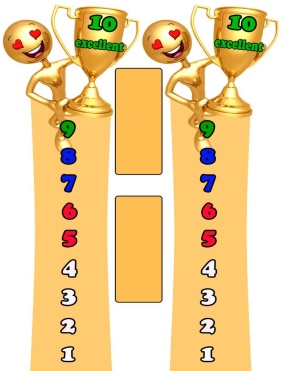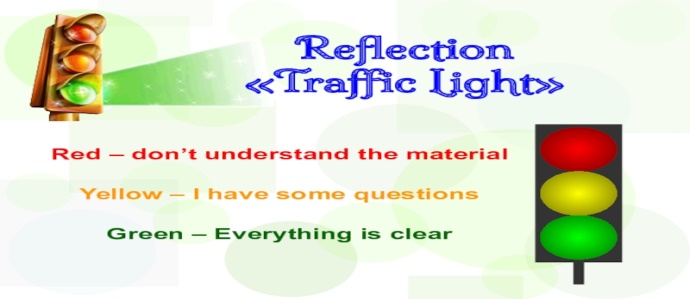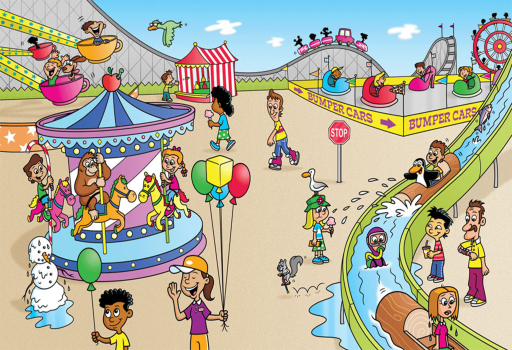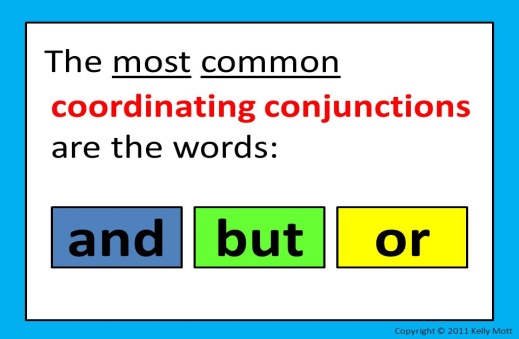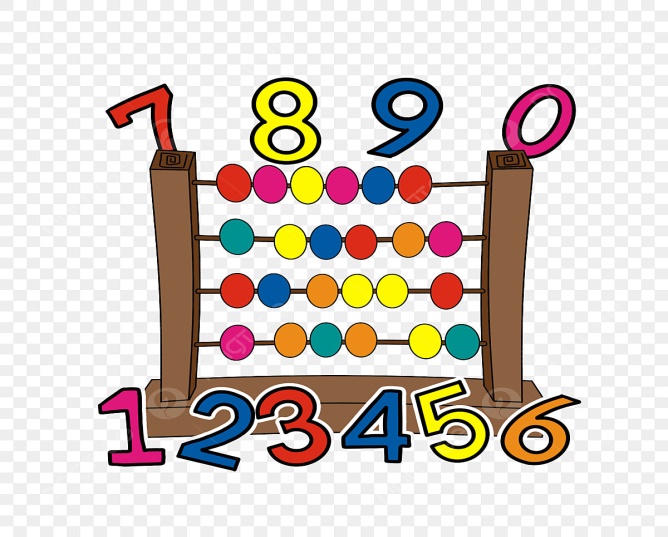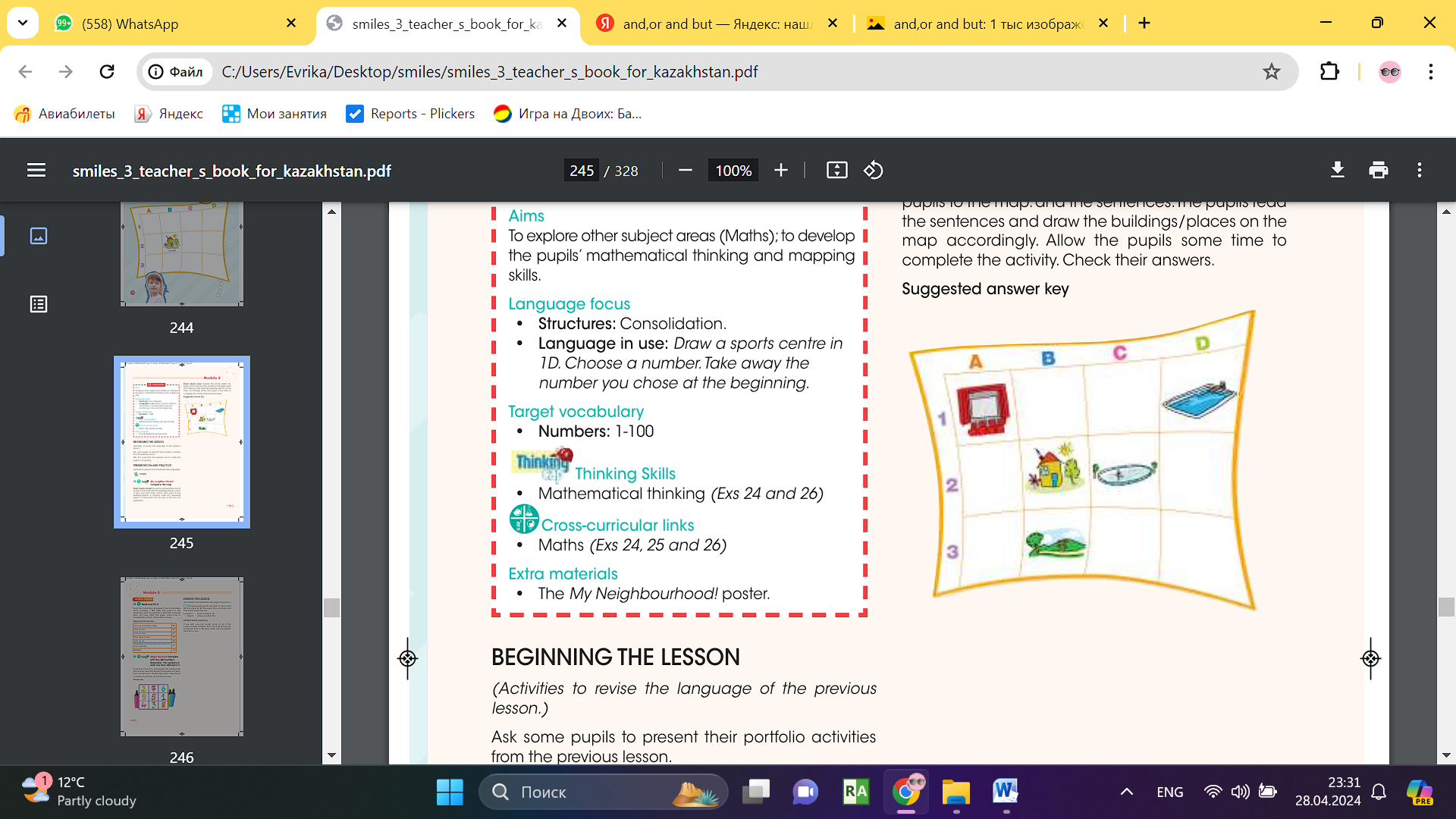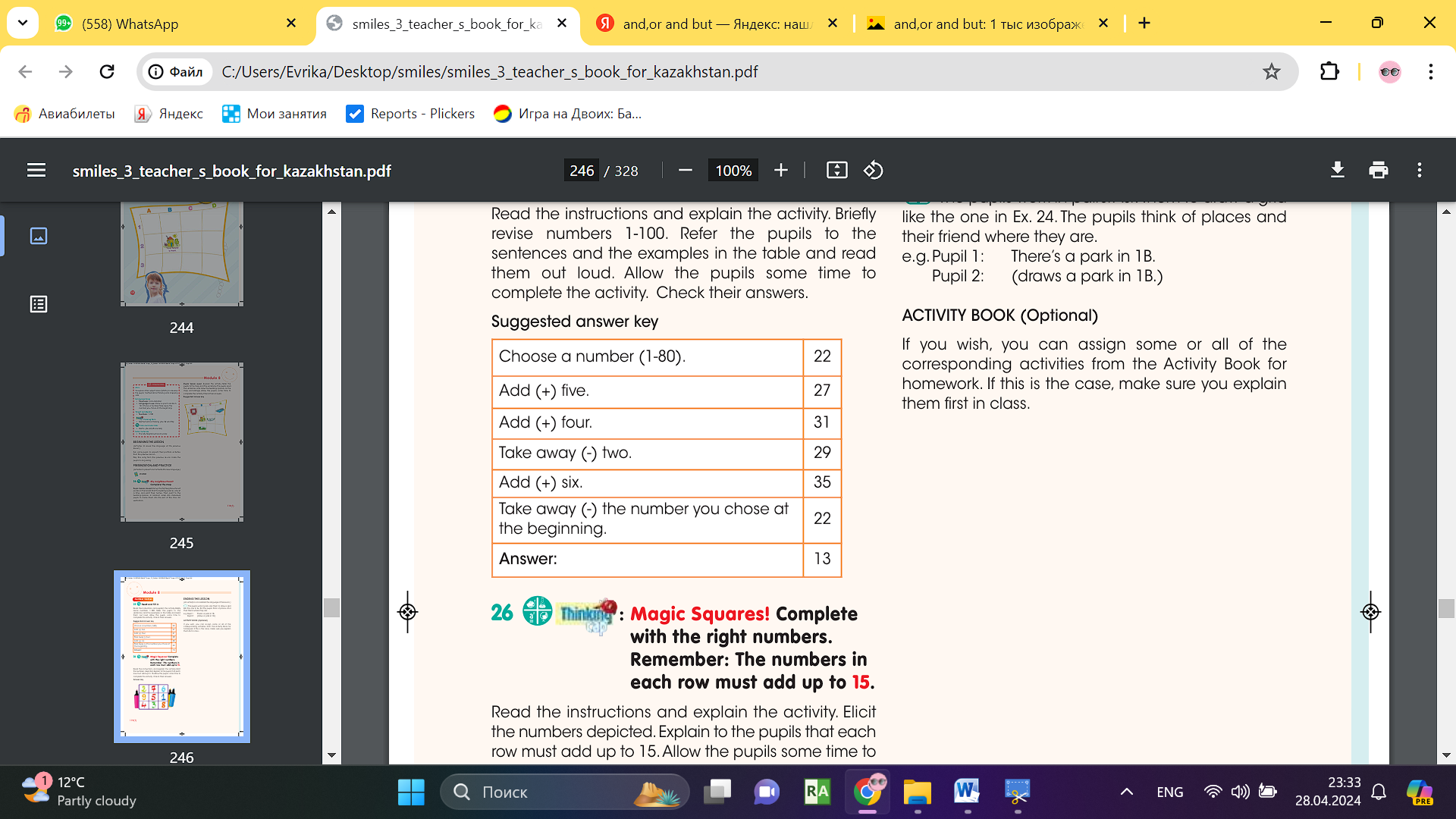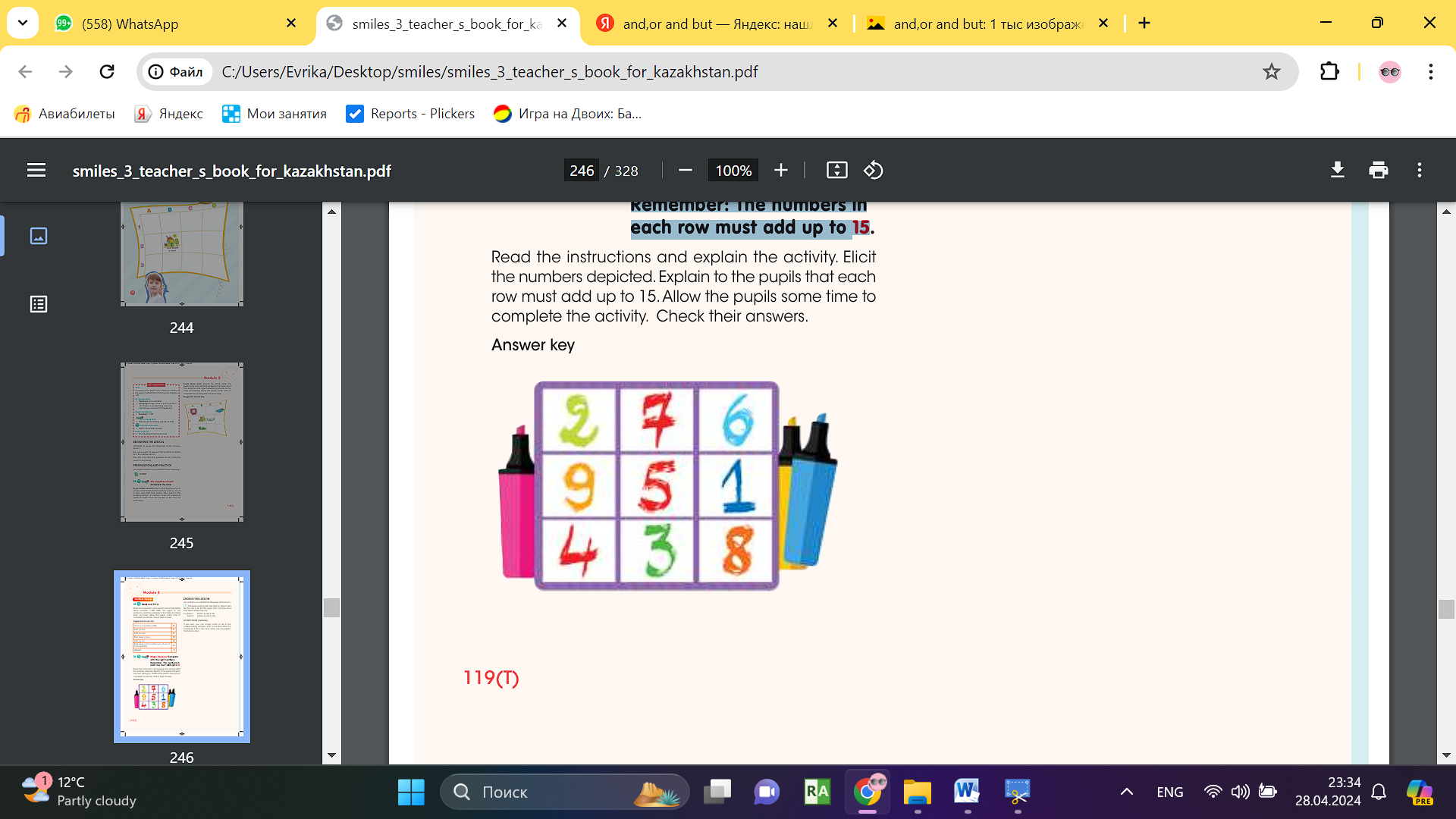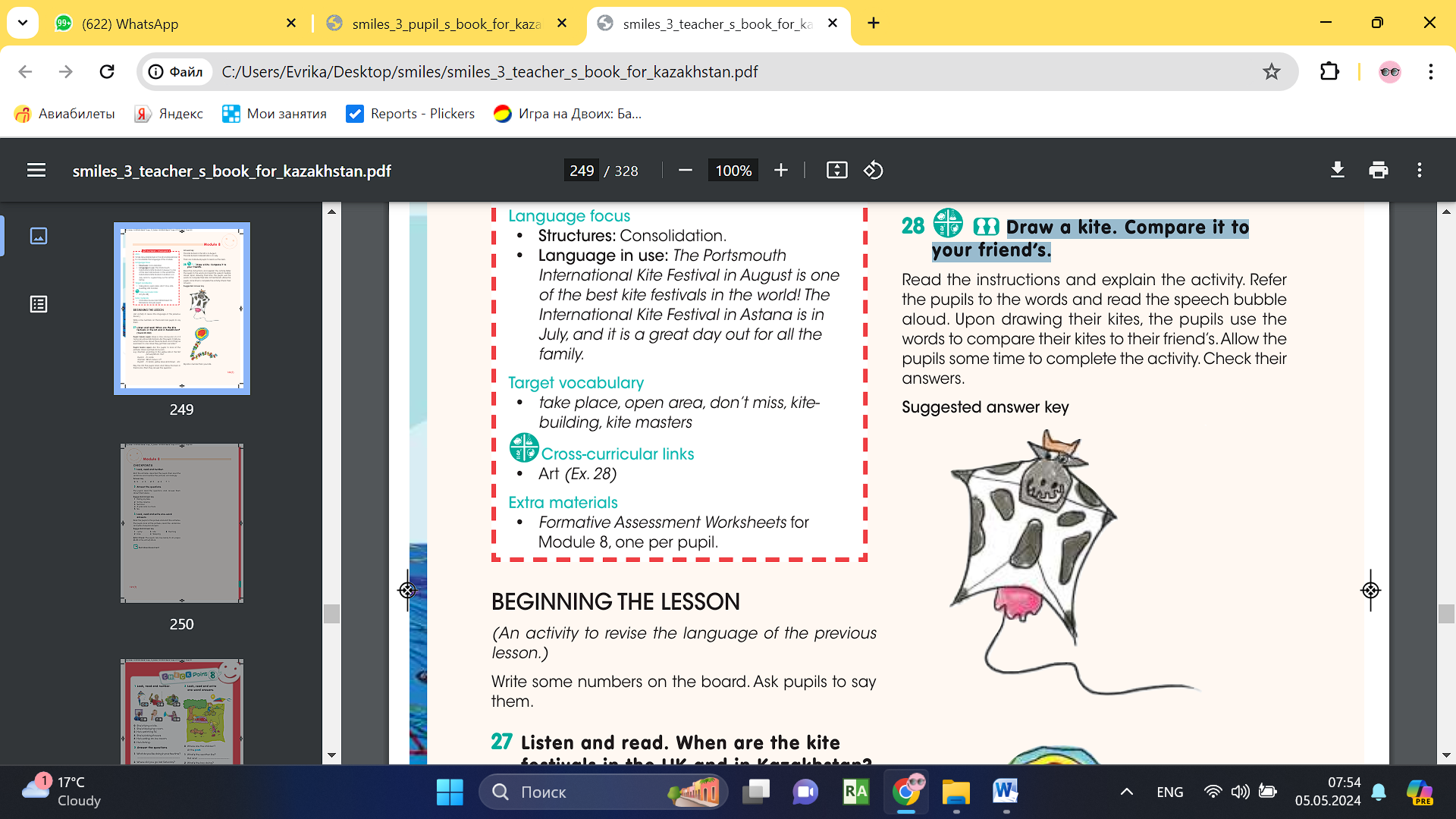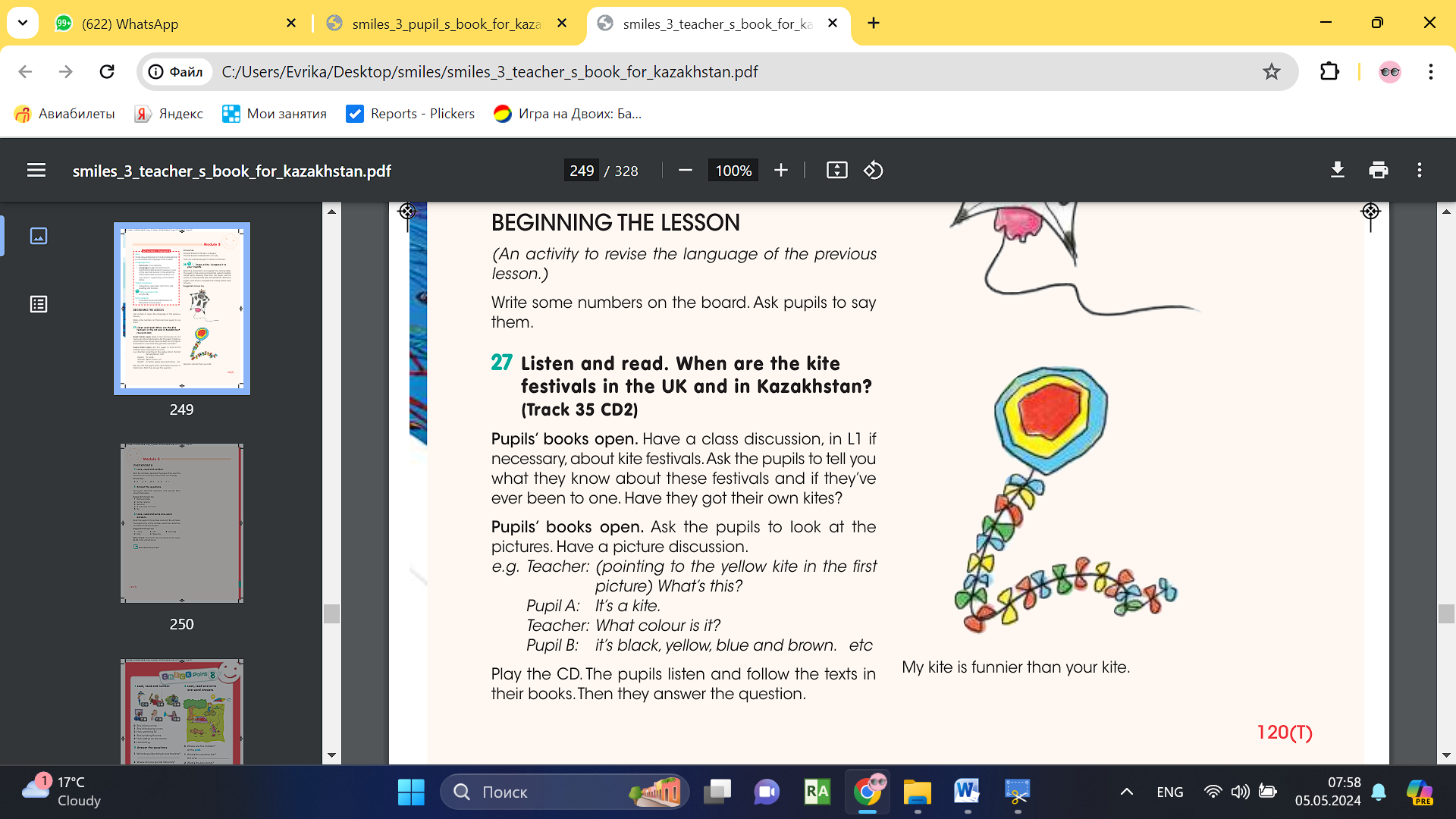Назар аударыңыз. Бұл материалды сайт қолданушысы жариялаған. Егер материал сіздің авторлық құқығыңызды бұзса, осында жазыңыз. Біз ең жылдам уақытта материалды сайттан өшіреміз
Жақын арада сайт әкімшілігі сізбен хабарласады

Бонусты жинап картаңызға (kaspi Gold, Halyk bank) шығарып аласыз


Сабақ жоспары, 3-сынып
Дипломдар мен сертификаттарды алып үлгеріңіз!


Материалдың толық нұсқасын
жүктеп алып көруге болады
Short term plan: term 4
|
Unit7:Water, water everywhere |
Lesson 53 |
||
|
Teacher name: |
|
||
|
Date: |
|
||
|
Grade: 3 |
Number present: |
absent: |
|
|
Lesson title |
Rain, rain |
||
|
Learning objectives |
3.2.5.1 clearly pronounce familiar words, short phrases when reading aloud; 3.3.1.1 recognize, identify and pronounce with support a limited number of familiar words in simple sentences; |
||
|
Lesson objectives |
Learners will be able to: - speak, read, and write words related to the water usage. |
||
|
Value links |
Respect each other Be friendly |
||
|
Plan |
|||
|
Stages / Time |
Teachers actions |
Students actions |
Assessment criteria |
Resources |
|
Beginning of the lesson Warming-up
3 min. Pre-learning «Brainstorming» method 7 min. |
Organization moment : 1.Greeting. Ask about the weather. The teacher sets the lesson objectives, letting students know what to anticipate from the lesson. Warming up Where are you from? How old are you? What color is it? How many students are there in class? What day of the week today? Lead – In
|
The aim: To develop pupils speaking skills and create friendly atmosphere Efficiency: By wishing each other they feel better and feel the support of others Students of the class are listed. Students' attention is drawn to the lesson. Students say different words from the picture •Learners remember previous lesson vocabulary •Learners answer the questions |
The teacher to assess learners for their ability. “Good job! Well done!” Formative Assessment
Good job! Descriptor: - remembers the lesson passed Point 1 |
Pictures worksheet Picture |
|
Middle of the lesson Presentation part. 30 min |
Pre-teach Teacher will pre-teach any necessary vocabulary for their class: rain, clouds, sky, sun, water, ground, sea, river, lake. Ex:1 P:95 Refer the pupils to the picture and ask: Where is she? Read the instruction and explain the activity. Allow the pupils some time to look at the picture on page 94 and answer the questions. Speaking. Pair work What can you see in this picture? Do you like this picture? Why/why not?(open question) What kind of weather do you like? Ex: 2 P: 95 Read the instruction and explain the activity. Refer the pupils to the sentences at the end of Ex2 and read them out loud. Allow the pupils some time to read the words and tick the ones they need when it’s rainy and put cross if you needn’t it. Look at the pictures and describe them. Use vocabulary connected with new theme. Is it sunny/rainy? Where are they? What do they wear? Do they need something else? Ex: 3 P: 95 Explain the activity. How much does it rain in a week. Make a measure. Conclusion during the lesson some tasks differentiated by outcomes of the students and by their abilities. |
• Pupils look at the picture and answer the question. ANSWERS Student’s own answer «Visual aids» method. Refer the pupils to the pictures and ask: Do you need it when it’s rainy? They should say Yes or no. • Pupils put a tick (✓) or a cross (x). Then say. ANSWERS 1 boots ✓ 2 sandals x 3 shorts x 4 umbrella✓ 5 raincoat✓ 6 T-shirt x • Pupils craftwork. In groups make and measure. ANSWERS Student’s own answer |
Descriptor: - look at the picture - answer the question Total: 3 point
Self assessment Descriptor: - read the instruction - put a tick and cross Total: 3 point Differentiation: «Verbal support» method is used to help Ss use new words in the sentences. Descriptor: - make and measure. Total: 3 point -Make CCQ questions Yes / No |
Card Worksheet Students book |
|
End of the lesson 5 min |
FEEDBACK Traffic light method is used to find out was the lesson clear or not. Use the stickers. |
|
Poster Success
|
|
Short term plan: term 4
|
Unit7:Water, water everywhere |
Lesson 54 |
||
|
Teacher name: |
|
||
|
Date: |
|
||
|
Grade: 3 |
Number present: |
absent: |
|
|
Lesson title |
By the sea |
||
|
Learning objectives |
3.1.5.1 distinguish phonemically different words; 3.4.7.1 correctly write down a larger number of familiar frequently used words when performing writing activities under the guidance of a teacher; |
||
|
Lesson objectives |
Learners will be able to: - To talk about actions related to water sports; to talk about actions happening now |
||
|
Value links |
Respect each other Be friendly |
||
|
Plan |
|||
|
Stages / Time |
Teachers actions |
Students actions |
Assessment criteria |
Resources |
|
Beginning of the lesson Warming-up
3 min. Pre-learning «Brainstorming» method 7 min. |
Organization moment : 1.Greeting. Ask about the weather. The teacher sets the lesson objectives, letting students know what to anticipate from the lesson. Warming up Where are you from? How old are you? What color is it? How many students are there in class? What day of the week today? Lead – In
|
The aim: To develop pupils speaking skills and create friendly atmosphere Efficiency: By wishing each other they feel better and feel the support of others Students of the class are listed. Students' attention is drawn to the lesson. Students say different words from the picture •Learners remember previous lesson vocabulary •Learners answer the questions |
The teacher to assess learners for their ability. “Good job! Well done!” Formative Assessment
Good job! Descriptor: - remembers the lesson passed Point 1 Assessment criteria talk about actions related to water sports |
Pictures worksheet Picture |
|
Middle of the lesson Presentation part. 30 min |
Ex:4 P:96 Put up the Have fun! poster on the board. Point to the activities and say the corresponding word. Pupils repeat ,after ask pupils. The pupils repeat, chorally and/or individually. Point to each picture in random order. Ask individual pupils to name them. Play the CD. The pupils listen, point to the words and repeat. Then pupils complete the activity. Ex: 5 P: 96 Explain the activity. Play the CD, twice if necessary. The pupils listen and complete the activity. Check their answers Ex: 6 P: 96 The pupils look at the picture in Ex. 5 for one minute and then close their books. Make false statements about the picture. The pupils correct your statements. Ex: 7 P: 97 Mime, say and then write: I am surfing. The pupils repeat, chorally and/or individually. Underline the verb and explain that this tense is called the present continuous. Then elicit how it is formed. Explain that we use it to talk about actions happening now, at the moment of speaking. Elicit the rest of the persons in the affirmative. Follow the same procedure to present the negative and interrogative forms as well as the short answers. Ex: 8 P: 97 Refer the pupils to the postcard. Allow the pupils some time to complete the activity. Check their answers. Conclusion during the lesson some tasks differentiated by outcomes of the students and by their abilities. |
• Pupils listen, point and repeat. Then match ANSWERS 1 a 2 f 3 d 4 b 5 c 6 e • Pupils listen and match. There is one extra child in the picture. ANSWERS 1 a 2 e 3 c 4 b 5 f • Pupils Let’s Play ANSWERS Teacher: Bob is sailing. Pupil A: No, he isn’t. He’s surfing. Etc Differentiation: «Verbal support» method is used to help Ss use new words in the sentences. • Pupils complete the sentences. Then match. ANSWERS 1 a 2 are sailing, c 3 is looking, f 4 is diving, e 5 are surfing, d 6 is fishing, b • Pupils read and complete. ANSWERS 2 is water skiing 3 is diving 4 are swimming 5 am writing |
Descriptor: - point to each picture - pronounce words correctly Total: 2 point
Descriptor: - find correct answers. - read words without mistakes Total: 2 point Descriptor: - look at the picture - make false statements Total: 2 point Descriptor: - correct answer - read the words correctly Total: 2 point Descriptor: - write without mistakes - read the words correctly Total: 2 point -Make CCQ questions Yes / No |
Card Worksheet Students book |
|
End of the lesson 5 min |
FEEDBACK Traffic light method is used to find out was the lesson clear or not. Use the stickers. |
|
Poster Success
|
|
Short term plan: term 4
|
Unit7:Water, water everywhere |
Lesson 55 |
||
|
Teacher name: |
|
||
|
Date: |
|
||
|
Grade: 3 |
Number present: |
absent: |
|
|
Lesson title |
By the sea |
||
|
Learning objectives |
3.1.5.1 distinguish between phonemically distinct words; 3.4.7.1 spell a growing number of familiar high-frequency words accurately during guided writing activities; 3.5.10.1 use common present continuous forms, including short answers and contractions, to talk about what is happening now |
||
|
Lesson objectives |
Learners will be able to: - To listen to and read a story about the characters doing water sports; to practise talking about actions; to learn how to pronounce the sound /w/. |
||
|
Value links |
Respect each other Be friendly |
||
|
Plan |
|||
|
Stages / Time |
Teachers actions |
Students actions |
Assessment criteria |
Resources |
|
Beginning of the lesson Warming-up
3 min. Pre-learning «Brainstorming» method 7 min. |
Organization moment : 1.Greeting. Ask about the weather. The teacher sets the lesson objectives, letting students know what to anticipate from the lesson. Warming up Where are you from? How old are you? What color is it? How many students are there in class? What day of the week today? Lead – In
|
The aim: To develop pupils speaking skills and create friendly atmosphere Efficiency: By wishing each other they feel better and feel the support of others Students of the class are listed. Students' attention is drawn to the lesson. Students say different words from the picture •Learners remember previous lesson vocabulary •Learners answer the questions |
The teacher to assess learners for their ability. “Good job! Well done!” Formative Assessment
Good job! Descriptor: - remembers the lesson passed Point 1 Assessment criteria listen to and read a story about the characters |
Pictures worksheet Picture |
|
Middle of the lesson Presentation part. 30 min |
Ex:10 P:98 Go through the pictures of the story and set the scene by asking the pupils questions about what they can see in the pictures. Play the CD. The pupils listen and follow the story in their books. Ex: 11 P: 99 Allow the pupils some time to read the story silently and complete the activity. Check the pupils’ answers Ex: 12 P: 99 Explain the activity. Allow the pupils some time to complete the activity. Check the pupils’ answers. Ex: 14 P: 99 Refer the pupils to the picture and the dialogue. Play the CD. The pupils listen and follow along. Pause the CD for the pupils to repeat, chorally and/or individually. The pupils, in pairs, act out similar dialogues about themselves. Go around the classroom providing any necessary help. Ask some pairs to come to the front of the classroom and act out the dialogue. If you wish, write the following on the board so the pupils can refer to it while they are completing the activity Ex: 15 P: 99 Refer the pupils to the pictures. Point to the picture of walrus and say: w /w/ – walrus. The pupils repeat, chorally and/or individually. Check their pronunciation. Repeat the procedure for water. Point to the picture of whiskers and say: w /w/ - whiskers. The pupils repeat, chorally and/or individually. Focus the pupils’ attention on the letters wh. Repeat the procedure for white Conclusion during the lesson some tasks differentiated by outcomes of the students and by their abilities. |
• Pupils listen and read. ANSWERS Teacher: (pointing to Lilly and Liam in picture 1) Who are they? Class: Lilly and Liam! Teacher: What are they doing? Class: They are sailing! etc • Pupils read the story and say True or False. ANSWERS 1 True 2 False 3 False 4 True • Pupils read the story again. Who says ... ANSWERS 1 Nanny Rose 2 Daisy Differentiation: «Verbal support» method is used to help Ss use new words in the sentences. • Pupils talking point. Listen and read. Make a new dialogue with your friend. ANSWERS Ulan: Hey! What are you doing? Assel: Look at me! I’m water skiing! Ulan Well done! • Pupils listen, point and repeat. ANSWERS what, well, wet |
Descriptor: - pronounce words correctly - give correct answers Total: 2 point
Descriptor: - read the story - complete the activity Total: 2 point Descriptor: - read the story - complete the activity Total: 2 point Descriptor: - listen and read - make a new dialogue Total: 2 point Descriptor: - point to the picture - repeat, chorally and/or individually Total: 2 point -Make CCQ questions Yes / No |
Card Worksheet Students book |
|
End of the lesson 5 min |
FEEDBACK Traffic light method is used to find out was the lesson clear or not. Use the stickers. |
|
Poster Success
|
|
Short term plan: term 4
|
Unit7:Water, water everywhere |
Lesson 56 |
||
|
Teacher name: |
|
||
|
Date: |
|
||
|
Grade: 3 |
Number present: |
absent: |
|
|
Lesson title |
A beach story |
||
|
Learning objectives |
3.3.6.1 understand with considerable support, some specific information and detail in short, simple texts on a limited range of general and some curricular topics; 3.4.8.1 include appropriate use of a full stop during guided writing of short, familiar sentences; |
||
|
Lesson objectives |
Learners will be able to: - To describe actions; to talk about ability. |
||
|
Value links |
Respect each other Be friendly |
||
|
Plan |
|||
|
Stages / Time |
Teachers actions |
Students actions |
Assessment criteria |
Resources |
|
Beginning of the lesson Warming-up
3 min. Pre-learning «Brainstorming» method 7 min. |
Organization moment : 1.Greeting. Ask about the weather. The teacher sets the lesson objectives, letting students know what to anticipate from the lesson. Warming up Where are you from? How old are you? What color is it? How many students are there in class? What day of the week today? Lead – In
|
The aim: To develop pupils speaking skills and create friendly atmosphere Efficiency: By wishing each other they feel better and feel the support of others Students of the class are listed. Students' attention is drawn to the lesson. Students say different words from the picture •Learners remember previous lesson vocabulary •Learners answer the questions |
The teacher to assess learners for their ability. “Good job! Well done!” Formative Assessment
Good job! Descriptor: - remembers the lesson passed Point 1 Assessment criteria describe actions, talk about ability |
Pictures worksheet Picture |
|
Middle of the lesson Presentation part. 30 min |
Ex:17 P:100 Put up the Have Fun! poster on the board. Point to each action, one at a time, and say the corresponding words/phrases. The pupils repeat, chorally and/or individually. Point to each action in random order. Ask individual pupils to name the action. Ask the rest of the class for verification. Ex: 18 P: 100 Explain the activity. Allow the pupils some time to unscramble the letters and write the words. Then they say which item isn’t Korkem’s. Check their answers. Ex: 19 P: 101 Revise the verb can. Say, then write: I can skip. The pupils repeat after you. Follow the same procedure and present/revise persons in the affirmative, negative and interrogative. The pupils look at the prompts and the faces and make sentences accordingly. Check their answers. Ex: 20 P: 101 Say and write on the board: I can sing really well. He is a quick swimmer. He swims quickly. Underline the words in bold. The pupils repeat, chorally and/or individually. Explain that quick is an adjective that describes what kind of swimmer he is and quickly is an adverb of manner that describes how he swims. Explain how adverbs are usually formed (adjective + - ly). Point out that well is an irregular adverb. Follow the same procedure to present fast. Conclusion during the lesson some tasks differentiated by outcomes of the students and by their abilities. |
• Pupils listen, point and repeat. Then match. ANSWERS 2 c 3 f 4 d 5 g 6 a 7 b • Pupils complete Korkem’s poem. Then say which thing is not Korkem’s. ANSWERS 2 jog 3 skip 4 play 5 do • Pupils make sentences ANSWERS 2 We can’t have a picnic today. 3 Sanzhar can jog all day. 4 Bakhytzhan can’t surf at all. 5 Ayaulym can sail with us. Differentiation: «Verbal support» method is used to help Ss use new words in the sentences. • Pupils what can Khan Sultan do? Look and say. ANSWERS 2 He can play the violin very beautifully. 3 He can do karate very well. 4 He can skip very quickly. 5 He can ride his bike very fast. |
Descriptor: - can pronounce correctly - give correct answers Total: 2 point
Descriptor: - find correct answers - write the words correctly Total: 2 point Descriptor: - make sentences without mistakes - make sentences accordingly Total: 2 point Descriptor: - pronounce sentences, words correctly - give correct answer Total: 2 point -Make CCQ questions Yes / No |
Card Worksheet Students book |
|
End of the lesson 5 min |
FEEDBACK Traffic light method is used to find out was the lesson clear or not. Use the stickers. |
|
Poster Success
|
|
Short term plan: term 4
|
Unit7:Water, water everywhere |
Lesson 57 |
||
|
Teacher name: |
|
||
|
Date: |
|
||
|
Grade: 3 |
Number present: |
absent: |
|
|
Lesson title |
A beach story Summative assessment for the unit «Water, water everywhere» |
||
|
Learning objectives |
3.3.6.1 understand factual information and details with significant support in short, uncomplicated texts on a limited range of general and educational topics; 3.4.8.1 correctly put a period when writing short, familiar sentences under the guidance of a teacher; |
||
|
Lesson objectives |
Learners will be able to: - To revise actions; to write about Summer Camp; to develop the pupils’ listening skills through a song |
||
|
Value links |
Respect each other Be friendly |
||
|
Plan |
|||
|
Stages / Time |
Teachers actions |
Students actions |
Assessment criteria |
Resources |
|
Beginning of the lesson Warming-up
3 min. Pre-learning «Brainstorming» method 7 min. |
Organization moment : 1.Greeting. Ask about the weather. The teacher sets the lesson objectives, letting students know what to anticipate from the lesson. Warming up Where are you from? How old are you? What color is it? How many students are there in class? What day of the week today? Lead – In
|
The aim: To develop pupils speaking skills and create friendly atmosphere Efficiency: By wishing each other they feel better and feel the support of others Students of the class are listed. Students' attention is drawn to the lesson. Students say different words from the picture •Learners remember previous lesson vocabulary •Learners answer the questions |
The teacher to assess learners for their ability. “Good job! Well done!” Formative Assessment
Good job! Descriptor: - remembers the lesson passed Point 1 Assessment criteria describe actions, talk about ability |
Pictures worksheet Picture |
|
Middle of the lesson Presentation part. 30 min |
Ex:22 P:102 Explain the activity. Play the CD. The pupils listen and follow in their books. The pupils then read the texts silently and answer the questions. Ask the pupils to say which sentences helped them to answer the questions. Allow some time for the pupils to complete the activity. Check their answers. Ex: 23 P: 102 The pupils read the sentences and choose the correct answer. Allow the pupils some time to complete the activity. Check their answers. Ex: 24 P: 103 Point to the picture and ask: What is he doing? Elicit: He’s suring. Point to the song and say: We are sailing, we are suring, we are diving in the pool! The pupils repeat, chorally and/or individually. Follow the same procedure and present the rest of the song. During this stage, present/elicit any unknown words/phrases.. Ex: 25 P: 103 Explain the game. In pairs, the pupils take turns saying a number and their partners say what they can do with the item that corresponds to that number. Summative assessment for the unit «Water, water everywhere» Conclusion during the lesson some tasks differentiated by outcomes of the students and by their abilities. |
• Pupils listen and read. Then answer ANSWERS 1 Yes, she can. 2 She’s jogging. 3 He’s doing karate. 4 No, he isn’t. He’s eating an ice cream. • Pupils read and choose. ANSWERS 1 going 2 decide 3 see 4 hear 5 run home • Pupils Let’s Sing! ANSWERS Student’s own answer. Differentiation: «Verbal support» method is used to help Ss use new words in the sentences. • Pupils talk with your friend. ANSWERS A: Number two! B: You can skip with it! Number three! A: You can skateboard with it! Number four! etc |
Descriptor: - read the texts silently - answer the questions Total: 2 point
Descriptor: - find correct answers - choose the correct answer Total: 2 point Descriptor: - point to the song - make sentences accordingly Total: 2 point Descriptor: - talk with your friend. - give correct answer Total: 2 point -Make CCQ questions Yes / No |
Card Worksheet Students book |
|
End of the lesson 5 min |
FEEDBACK Traffic light method is used to find out was the lesson clear or not. Use the stickers. |
|
Poster Success
|
|
Short term plan: term 4
|
Unit7:Water, water everywhere |
Lesson 58 |
||
|
Teacher name: |
|
||
|
Date: |
|
||
|
Grade: 3 |
Number present: |
absent: |
|
|
Lesson title |
CLIL for time: Geography |
||
|
Learning objectives |
3.3.5.1 understand the main ideas of short simple texts on common familiar topics and some educational topics using contextual prompts; 3.5.15.1 use would you like to for an invitation and use the appropriate answers yes please, no thanks, use let's + verb, verbs go enjoy like + verb + ing |
||
|
Lesson objectives |
Learners will be able to: - To explore other subject areas (Geography); - to raise the pupils’ environmental awareness; to talk about the water cycle |
||
|
Value links |
Respect each other Be friendly |
||
|
Plan |
|||
|
Stages / Time |
Teachers actions |
Students actions |
Assessment criteria |
Resources |
|
Beginning of the lesson Warming-up
3 min. Pre-learning «Brainstorming» method 7 min. |
Organization moment : 1.Greeting. Ask about the weather. The teacher sets the lesson objectives, letting students know what to anticipate from the lesson. Warming up Where are you from? How old are you? What color is it? How many students are there in class? What day of the week today? Lead – In
|
The aim: To develop pupils speaking skills and create friendly atmosphere Efficiency: By wishing each other they feel better and feel the support of others Students of the class are listed. Students' attention is drawn to the lesson. Students say different words from the picture •Learners remember previous lesson vocabulary •Learners answer the questions |
The teacher to assess learners for their ability. “Good job! Well done!” Formative Assessment
Good job! Descriptor: - remembers the lesson passed Point 1 Assessment criteria describe actions, talk about ability |
Pictures worksheet Picture |
|
Middle of the lesson Presentation part. 30 min |
Ex:26 P:104 Put up the Water Cycle! poster on the board. Explain to the pupils, in L1 if necessary, that the water cycle involves the sea, air and the ground. Point to the water drop and say: drop. The pupils repeat, chorally and/or individually. Then point to the drop surfing in the ocean and explain that the sun was very hot, so the drop changed into water vapour. Write on the board and say: water vapour. The pupils repeat, chorally and/or individually. Follow the same procedure to present the rest of the water cycle. Ex: 27 P: 105 Read the instructions and explain the activity. Go through the sentences and explain/elicit any unknown words. Allow the pupils some time to complete the quiz. Check their answers. Ex: 28 P: 105 Read the instructions and explain the activity. Refer the pupils to the pictures and elicit each step of the experiment. Go around the classroom, providing help with the bottles. When the pupils complete the experiment, they report back to the class. Conclusion during the lesson some tasks differentiated by outcomes of the students and by their abilities. |
• Pupils read. Then match. The Water Cycle! ANSWERS 1 c 2 a 3 d 4 b • Pupils do the quiz and find out! Are you good at Geography? ANSWERS 2 C 3 B 4 C 5 A • Pupils in groups, make and measure. How much does it rain in a week? ANSWERS Tuesday 5 centimetres Wednesday 6 centimetres etc |
Descriptor: - read the texts silently - answer the questions Total: 2 point
Descriptor: - do the quiz - complete the quiz. Total: 2 point Descriptor: - work in groups - make and measure Total: 2 point -Make CCQ questions Yes / No |
Card Worksheet Students book |
|
End of the lesson 5 min |
FEEDBACK Traffic light method is used to find out was the lesson clear or not. Use the stickers. |
|
Poster Success
|
|
Short term plan: term 4
|
Unit7:Water, water everywhere |
Lesson 59 |
||
|
Teacher name: |
|
||
|
Date: |
|
||
|
Grade: 3 |
Number present: |
absent: |
|
|
Lesson title |
Our world. checkpoint |
||
|
Learning objectives |
3.4.7.1 spell a growing number of familiar high-frequency words accurately during guided writing activities; 3.5.10.1 use common present continuous forms, including short answers and contractions, to talk about what is happening now |
||
|
Lesson objectives |
Learners will be able to: - To talk about famous athletes from the USA, Russia and Kazakhstan; - to consolidate the language of Module 7. |
||
|
Value links |
Respect each other Be friendly |
||
|
Plan |
|||
|
Stages / Time |
Teachers actions |
Students actions |
Assessment criteria |
Resources |
|
Beginning of the lesson Warming-up
3 min. Pre-learning «Brainstorming» method 7 min. |
Organization moment : 1.Greeting. Ask about the weather. The teacher sets the lesson objectives, letting students know what to anticipate from the lesson. Warming up Where are you from? How old are you? What color is it? How many students are there in class? What day of the week today? Lead – In
|
The aim: To develop pupils speaking skills and create friendly atmosphere Efficiency: By wishing each other they feel better and feel the support of others Students of the class are listed. Students' attention is drawn to the lesson. Students say different words from the picture •Learners remember previous lesson vocabulary •Learners answer the questions |
The teacher to assess learners for their ability. “Good job! Well done!” Formative Assessment
Good job! Descriptor: - remembers the lesson passed Point 1 Assessment criteria describe actions, talk about ability |
Pictures worksheet Picture |
|
Middle of the lesson Presentation part. 30 min |
Ex:29 P:106 Tell the pupils you will talk about famous athletes today. Brainstorm famous sports stars and write their names on the board. Ask the pupils, in L1 if necessary, who their favourite athletes are and why. Have the pupils look at the pictures. Ask them if they recognise the people presented and elicit what they can do really well (surf, swim, dive). Play the CD and ask the pupils to listen and follow the texts in their books. Ex: 30 P: 106 Allow the pupils some time to complete the activity. Check their answers. Ex: 1 P: 107 Elicit the activities depicted. The pupils then read the sentences and number the pictures accordingly Ex: 2 P: 107 The pupils read the sentences and complete them using the present continuous. Ex: 3 P: 107 Elicit the pictures. The pupils look at the pictures, read the sentences and underline the correct words in bold. Conclusion during the lesson some tasks differentiated by outcomes of the students and by their abilities. |
• Pupils listen and read. ANSWERS Student’s own answer • Pupils read and match. ANSWERS 1 b 2 c 3 a • Pupils look, read and number ANSWERS B 5 C 2 D 1 E 3 F 4 • Pupils read and complete. ANSWERS 1 Is Dana swimming 2 is playing 3 am getting 4 is surfing • Pupils look, read and underline. What do they like doing at the seaside? ANSWERS 2 going sailing 3 eating ice cream |
Descriptor: - talk about famous athletes today - listen and read Total: 2 point
Descriptor: - read and match - complete the activity Total: 2 point Descriptor: - read the sentences - number the pictures Total: 2 point Descriptor: - read the sentences - underline the correct words in bold. Total: 2 point -Make CCQ questions Yes / No |
Card Worksheet Students book |
|
End of the lesson 5 min |
FEEDBACK Traffic light method is used to find out was the lesson clear or not. Use the stickers. |
|
Poster Success
|
|
Short term plan: term 4
|
Unit8: Having fun |
Lesson 60 |
||
|
Teacher name: |
|
||
|
Date: |
|
||
|
Grade: 3 |
Number present: |
absent: |
|
|
Lesson title |
Fun places |
||
|
Learning objectives |
3.1.7.1 use contextual hints to predict the content of small dialogues with support on general and educational topics; 3.2.8.1 retell short, uncomplicated stories and events within a limited range of general and educational topics; 3.3.3.1 read short, uncomplicated fiction and popular science texts on a limited range of general and educational topics with standard support; |
||
|
Lesson objectives |
Learners will be able to: - To talk about favourite places and free-time activities. |
||
|
Value links |
Respect each other Be friendly |
||
|
Plan |
|||
|
Stages / Time |
Teachers actions |
Students actions |
Assessment criteria |
Resources |
|
Beginning of the lesson Warming-up
3 min. Pre-learning «Brainstorming» method 7 min. |
Organization moment : 1.Greeting. Ask about the weather. The teacher sets the lesson objectives, letting students know what to anticipate from the lesson. Warming up Where are you from? How old are you? What color is it? How many students are there in class? What day of the week today? Lead – In
|
The aim: To develop pupils speaking skills and create friendly atmosphere Efficiency: By wishing each other they feel better and feel the support of others Students of the class are listed. Students' attention is drawn to the lesson. Students say different words from the picture •Learners remember previous lesson vocabulary •Learners answer the questions |
The teacher to assess learners for their ability. “Good job! Well done!” Formative Assessment
Good job! Descriptor: - remembers the lesson passed Point 1 Assessment criteria describe actions, talk about ability |
Pictures worksheet Picture |
|
Middle of the lesson Presentation part. 30 min |
Ex:1 P:109 Refer the pupils to the picture and ask: Where are they? Elicit: At the cinema. Have a class discussion, in L1 if necessary, about different free-time activities. Read the instructions and explain the activity. Allow the pupils some time to look at the picture on page 108 and answer the questions. Check their answers. Ex: 2 P: 109 Read the instructions and explain the activity. Refer the pupils to the places and explain/elicit their meaning. Refer the pupils to the sentences at the end of Ex. 2 and read them out loud. Allow the pupils some time to read the words/phrases and talk about where they like going in their free time. Ask a few pairs to report back to the class. Check their answers. Ex: 3 P: 109 Explain the activity. Refer the pupils to the pictures and ask the pupils what they can see. Elicit the different places. Play the CD, twice if necessary. The pupils listen and match. Check the pupils’ answers. Conclusion during the lesson some tasks differentiated by outcomes of the students and by their abilities. |
• Pupils look at the picture. Where are they? What are they doing? ANSWERS They are at the cinema. They are watching a film. • Pupils choose and talk with your friend. Where do you like going in your free time? ANSWERS A: I like going to the skating rink in my free time. B: Me, too!/I don’t. I like going to the park with my friends. etc • Pupils listen and match. There is one extra place. Where did they go last Saturday? ANSWERS 1 b 2 c 3 a |
Descriptor: - talk about famous athletes today - listen and read Total: 2 point
Descriptor: - read and match - complete the activity Total: 2 point Descriptor: - read the sentences - number the pictures Total: 2 point -Make CCQ questions Yes / No |
Card Worksheet Students book |
|
End of the lesson 5 min |
FEEDBACK Traffic light method is used to find out was the lesson clear or not. Use the stickers. |
|
Poster Success
|
|
Short term plan: term 4
|
Unit8: Having fun |
Lesson 61 |
||
|
Teacher name: |
|
||
|
Date: |
|
||
|
Grade: 3 |
Number present: |
absent: |
|
|
Lesson title |
Fun places |
||
|
Learning objectives |
3.3.6.1 understand with considerable support factual information and details in short uncomplicated texts on a limited range of general and educational topics; 3.4.7.1 correctly write down more familiar frequently used words when performing writing activities under the guidance of a teacher |
||
|
Lesson objectives |
Learners will be able to: -To talk about seasons; to describe actions happening now; - to talk about seasons and seasonal activities. |
||
|
Value links |
Respect each other Be friendly |
||
|
Plan |
|||
|
Stages / Time |
Teachers actions |
Students actions |
Assessment criteria |
Resources |
|
Beginning of the lesson Warming-up
3 min. Pre-learning «Brainstorming» method 7 min. |
Organization moment : 1.Greeting. Ask about the weather. The teacher sets the lesson objectives, letting students know what to anticipate from the lesson. Warming up Where are you from? How old are you? What color is it? How many students are there in class? What day of the week today? Lead – In
|
The aim: To develop pupils speaking skills and create friendly atmosphere Efficiency: By wishing each other they feel better and feel the support of others Students of the class are listed. Students' attention is drawn to the lesson. Students say different words from the picture •Learners remember previous lesson vocabulary •Learners answer the questions |
The teacher to assess learners for their ability. “Good job! Well done!” Formative Assessment
Good job! Descriptor: - remembers the lesson passed Point 1 Assessment criteria describe actions, talk about ability |
Pictures worksheet Picture |
|
Middle of the lesson Presentation part. 30 min |
Ex:4 P:110 Put up the flashcards, one at a time, and say the corresponding words. The pupils repeat, chorally and/or individually. Point to each item in random order. Ask individual pupils to name the item. Ask the rest of the class for verification. Explain to the pupils that in today’s lesson you’ll talk about seasons. Ask them to tell you their favourite season. Ex: 5 P: 110 Read the instructions and explain the activity. Allow the pupils some time to complete the activity. Check their answers. Ex: 6 P: 111 Go through the examples in the Study spot table and revise present continuous (form and spelling). Read the example and explain the activity. Point to pictures 2-4 and elicit the actions (ride a bike, eat, read). Then ask the pupils to complete the questions and the answers. Allow the pupils enough time to complete the activity. Check their answers. Ex: 7 P: 111 Read the example and explain the game. Tell the pupils that they have to find the differences between the two pictures. If you want to make the game more competitive, you can divide the pupils into two teams, A and B. Every time a pupil from a team points out a difference, his/her team gets one point. The team with the most points wins. Conclusion during the lesson some tasks differentiated by outcomes of the students and by their abilities. |
• Pupils listen, point and repeat. Then read and match. ANSWERS 2 e 4 f 6 d 8 c 3 h 5 a 7 b • Pupils read and choose. ANSWERS 1 a 2 b 3 b 4 a • Pupils complete. Then answer ANSWERS 2 Is he/Yes, he is. 3 Is she/No, she isn’t. 4 Is he/No, he isn’t. • Pupils let’s play ANSWERS In Picture A, Liam is flying a kite. In picture B, he isn’t flying a kite. He’s riding a horse. In Picture A, Daisy is riding a bike. In picture B, she isn’t riding a bike. She’s flying a kite. In Picture A, Lilly is riding a horse. In picture B, she isn’t riding a horse. She’s riding a bike. In Picture A, Jake is playing football. In picture B, he isn’t playing football. He’s swimming. In Picture A, Charlie is swimming. In picture B, he isn’t swimming. He’s playing football. |
Descriptor: - repeat, chorally and/or individually. - read and match. Total: 2 point
Descriptor: - read and choose. - complete the activity Total: 2 point Descriptor: - read the example - complete the activity Total: 2 point -Make CCQ questions Yes / No |
Card Worksheet Students book |
|
End of the lesson 5 min |
FEEDBACK Traffic light method is used to find out was the lesson clear or not. Use the stickers. |
|
Poster Success
|
|
Short term plan: term 4
|
Unit8: Having fun |
Lesson 62 |
||
|
Teacher name: |
|
||
|
Date: |
|
||
|
Grade: 3 |
Number present: |
absent: |
|
|
Lesson title |
Number games |
||
|
Learning objectives |
3.1.1.1 understand short instructions with support for performing a wider range of activities in the lesson; 3.3.6.1 understand with significant support factual information and details in short simple texts on a limited range of general and educational topics |
||
|
Lesson objectives |
Learners will be able to: - To listen to and read a story about the characters flying their kites; - to talk about actions happening now; - to learn how to distinguish between and pronounce the sounds /s/ and /S/. |
||
|
Value links |
Respect each other Be friendly |
||
|
Plan |
|||
|
Stages / Time |
Teachers actions |
Students actions |
Assessment criteria |
Resources |
|
Beginning of the lesson Warming-up
3 min. Pre-learning «Brainstorming» method 7 min. |
Organization moment : 1.Greeting. Ask about the weather. The teacher sets the lesson objectives, letting students know what to anticipate from the lesson. Warming up Where are you from? How old are you? What color is it? How many students are there in class? What day of the week today? Lead – In
|
The aim: To develop pupils speaking skills and create friendly atmosphere Efficiency: By wishing each other they feel better and feel the support of others Students of the class are listed. Students' attention is drawn to the lesson. Students say different words from the picture •Learners remember previous lesson vocabulary •Learners answer the questions |
The teacher to assess learners for their ability. “Good job! Well done!” Formative Assessment
Good job! Descriptor: - remembers the lesson passed Point 1 Assessment criteria describe actions, talk about ability |
Pictures worksheet Picture |
|
Middle of the lesson Presentation part. 30 min |
Ex:8 P:112 Go through the pictures of the story and set the scene by asking the pupils questions about what they can see in the pictures. Teacher: (pointing to Lilly, Liam and Daisy in picture 1) Where are the children? Class: At the park. Teacher: (pointing to the kites) What have the children got? Class: Kites. etc Ex: 9 P: 112 Allow the pupils some time to read the story silently and complete the activity. Check the pupils’ answers. Ex:10 P: 112 Read the instructions and explain the activity. Allow the pupils some time to match the sentences in Ex. 9 to the people depicted. Check their answers. Ex:12 P: 113 Refer the pupils to the picture and the dialogue. Play the CD. The pupils listen and follow along. Pause the CD for the pupils to repeat, chorally and/or individually. The pupils, in pairs, act out similar dialogues about themselves. Go around the classroom providing any necessary help. Ask some of the pairs to come to the front of the classroom and act out the dialogue. Ex:13 P: 113 Refer the pupils to the picture of the sea and say: s /s/ – sea. The pupils repeat, chorally and/or individually. Check their pronunciation. Point to the picture of sheep and say: sh \S\ – sheep. The pupils repeat, chorally and/or individually. Check their pronunciation. Repeat the procedure for fish. Conclusion during the lesson some tasks differentiated by outcomes of the students and by their abilities. |
• Pupils listen and read ANSWERS Student’s own answer • Pupils read the story and complete ANSWERS 1 are 2 flying 3 worry 4 Spring • Pupils match the sentences in Ex. 9 to the people below. ANSWERS A 4 B 3 C 1 D 2 • Pupils talking point. Listen and read. Make a new dialogue with your friend. ANSWERS Marzhan: Hello, Sanzhar! What are you doing? Sanzhar: Hi, Marzhan. I’m fishing. Marzhan: Fishing is fantastic! Sanzhar: That’s why summer is my favourite season! • Pupils listen, point and repeat. ANSWERS Student’s own answer |
Descriptor: - listen and read - answer the question Total: 2 point
Descriptor: - read the story - complete the activity Total: 2 point Descriptor: - match the sentences - complete the activity Total: 2 point Descriptor: - listen and read - make a new dialogue Total: 2 point -Make CCQ questions Yes / No |
Card Worksheet Students book |
|
End of the lesson 5 min |
FEEDBACK Traffic light method is used to find out was the lesson clear or not. Use the stickers. |
|
Poster Success
|
|
Short term plan: term 4
|
Unit8: Having fun |
Lesson 63 |
||
|
Teacher name: |
|
||
|
Date: |
|
||
|
Grade: 3 |
Number present: |
absent: |
|
|
Lesson title |
Number games |
||
|
Learning objectives |
3.3.3.1 read short, uncomplicated fiction and popular science texts on a limited range of general and educational topics with standard support; 3.5.10.1 use common present continuous forms, including short answers and contractions, to talk about what is happening now |
||
|
Lesson objectives |
Learners will be able to: - To talk about actions happening now. |
||
|
Value links |
Respect each other Be friendly |
||
|
Plan |
|||
|
Stages / Time |
Teachers actions |
Students actions |
Assessment criteria |
Resources |
|
Beginning of the lesson Warming-up
3 min. Pre-learning «Brainstorming» method 7 min. |
Organization moment : 1.Greeting. Ask about the weather. The teacher sets the lesson objectives, letting students know what to anticipate from the lesson. Warming up Where are you from? How old are you? What color is it? How many students are there in class? What day of the week today? Lead – In
|
The aim: To develop pupils speaking skills and create friendly atmosphere Efficiency: By wishing each other they feel better and feel the support of others Students of the class are listed. Students' attention is drawn to the lesson. Students say different words from the picture •Learners remember previous lesson vocabulary •Learners answer the questions |
The teacher to assess learners for their ability. “Good job! Well done!” Formative Assessment
Good job! Descriptor: - remembers the lesson passed Point 1 Assessment criteria describe actions, talk about ability |
Pictures worksheet Picture |
|
Middle of the lesson Presentation part. 30 min |
Ex:15 P:114 Put up the flashcards on the board. Point to them, one at a time, and name them. The pupils repeat, chorally and/or individually. Repeat the procedure with the remaining flashcards. Then point to the flashcards in random order. Ask individual pupils to name them. Ex: 16 P: 114 Refer the pupils to the pictures and explain the activity. Then read the example aloud. The pupils use the numbers and the letters to describe the pictures, as in the example. Ask a few pairs to report back to the class. Check their answers. Ex:17 P: 115 Refer the pupils to the pictures and explain the activity. Then read the example aloud. The pupils use the numbers and the letters to describe the pictures, as in the example. Ask a few pairs to report back to the class. Check their answers. Ex:18 P: 115 Play the CD, twice if necessary. The pupils listen and complete the activity. Check the pupils’ answers. Conclusion during the lesson some tasks differentiated by outcomes of the students and by their abilities. |
• Pupils listen, point and repeat. Then number. ANSWERS sleep 2 listen to music 4 watch TV 7 tidy my room 6 drink milk 3 pick flowers 1 • Pupils talk with your friend. ANSWERS A: 2B B: They’re swimming. A: 3C B: They’re drinking milk. A: 3A B: She’s tidying her room. A: 1C B: She’s flying a kite. A: 2C B: He’s listening to music. A: 1B B: He’s watching TV. A: 2A B: She’s eating an ice cream. A: 3B B: They’re sleeping. • Pupils read and underline. ANSWERS 2 No, they aren’t. 3 Yes, we are. 4 Yes, they are. 5 No, we aren’t. • Pupils listen and choose. ANSWERS 2 b 3 b 4 a |
Descriptor: - listen, point and repeat - then number. Total: 2 point
Descriptor: - read the example aloud. - talk with your friend. Total: 2 point Descriptor: - use the numbers - describe the pictures Total: 2 point Descriptor: - read and underline. - complete the activity Total: 2 point -Make CCQ questions Yes / No |
Card Worksheet Students book |
|
End of the lesson 5 min |
FEEDBACK Traffic light method is used to find out was the lesson clear or not. Use the stickers. |
|
Poster Success
|
|
Short term plan: term 4
|
Unit8: Having fun |
Lesson 64 |
||
|
Teacher name: |
|
||
|
Date: |
|
||
|
Grade: 3 |
Number present: |
absent: |
|
|
Lesson title |
Flying kites Summative assessment for the unit «Having fun» |
||
|
Learning objectives |
3.1.1.1 understand short supported classroom instructions in an increasing range of classroom routines; 3.3.6.1 understand with considerable support, some specific information and detail in short, simple texts on a limited range of general and some curricular topics; 3.5.2.1 use cardinal numbers 1 – 100 to count and ordinal numbers 1 – 10; |
||
|
Lesson objectives |
Learners will be able to: - To talk about actions happening now; to write a diary entry; to consolidate seasons; to develop the pupils’ listening and writing skills through a song. |
||
|
Value links |
Respect each other Be friendly |
||
|
Plan |
|||
|
Stages / Time |
Teachers actions |
Students actions |
Assessment criteria |
Resources |
|
Beginning of the lesson Warming-up
3 min. Pre-learning «Brainstorming» method 7 min. |
Organization moment : 1.Greeting. Ask about the weather. The teacher sets the lesson objectives, letting students know what to anticipate from the lesson. Warming up Where are you from? How old are you? What color is it? How many students are there in class? What day of the week today? Lead – In
|
The aim: To develop pupils speaking skills and create friendly atmosphere Efficiency: By wishing each other they feel better and feel the support of others Students of the class are listed. Students' attention is drawn to the lesson. Students say different words from the picture •Learners remember previous lesson vocabulary •Learners answer the questions |
The teacher to assess learners for their ability. “Good job! Well done!” Formative Assessment
Good job! Descriptor: - remembers the lesson passed Point 1 Assessment criteria describe actions, talk about ability |
Pictures worksheet Picture |
|
Middle of the lesson Presentation part. 30 min |
Ex:20 P:115 Point to and present the word diary. Ask the pupils, in L1 if necessary, to tell you if they have got a diary and what they usually write in it. Play the CD. The pupils listen and follow along in their books. Allow the pupils some time to read the text silently and complete the activity. Check the pupils’ answers. Then pupils read out the text. Ex: 21 P: 116 Write the following on the board: I like spring and summer. Is the English test on Monday or Tuesday? I don’t like bananas, but I like apples. Underline the words in bold. Explain to the pupils that and, or and but help us link ideas in a sentence. We use and to join similar ideas. We use or to list two alternatives. We use but to join different ideas. Read the instructions and explain the activity. Allow the pupils some time to complete the sentences. Check their answers. Ex:23 P: 117 Explain to pupils that they have to write their own verse about their favourite season. Tell them to use the song from Ex. 22 as a model. Allow the pupils some time to complete the activity. Walk around the classroom providing any necessary help. Then ask individual pupils to read their songs. Summative assessment for the unit «Having fun» Conclusion during the lesson some tasks differentiated by outcomes of the students and by their abilities. |
• Pupils read and circle. Then listen and check. ANSWERS 2 watching TV 3 reading 4 sleeping 5 picking flowers • Pupils complete the sentences with and, or or but. ANSWERS 2 or 4 or 6 but 3 or 5 and • Pupils choose your favourite season. Write your own song. Then draw. ANSWERS Summer is here! It’s lots of fun! I’m swimming With everyone! |
Descriptor: - read and circle - listen and check Total: 2 point
Descriptor: - underline the words in bold. - complete the sentences with and, or or but. Total: 2 point Descriptor: - complete the sentences with and, or or but. - complete the activity Total: 2 point -Make CCQ questions Yes / No |
Card Worksheet Students book |
|
End of the lesson 5 min |
FEEDBACK Traffic light method is used to find out was the lesson clear or not. Use the stickers. |
|
Poster Success
|
|
Short term plan: term 4
|
Unit8: Having fun |
Lesson 65 |
||
|
Teacher name: |
|
||
|
Date: |
|
||
|
Grade: 3 |
Number present: |
absent: |
|
|
Lesson title |
Time for CLIL. Math |
||
|
Learning objectives |
3.1.6.1 understand some factual information with support in small text passages or dialogues on a limited range of general and educational topics; 3.2.4.1 answer questions within a limited range of general and educational topics; 3.3.4.1 use a simple dictionary with illustrations with little support; |
||
|
Lesson objectives |
Learners will be able to: - To explore other subject areas (Maths); - to develop the pupils’ mathematical thinking and mapping skills. |
||
|
Value links |
Respect each other Be friendly |
||
|
Plan |
|||
|
Stages / Time |
Teachers actions |
Students actions |
Assessment criteria |
Resources |
|
Beginning of the lesson Warming-up
3 min. Pre-learning «Brainstorming» method 7 min. |
Organization moment : 1.Greeting. Ask about the weather. The teacher sets the lesson objectives, letting students know what to anticipate from the lesson. Warming up Where are you from? How old are you? What color is it? How many students are there in class? What day of the week today? Lead – In
|
The aim: To develop pupils speaking skills and create friendly atmosphere Efficiency: By wishing each other they feel better and feel the support of others Students of the class are listed. Students' attention is drawn to the lesson. Students say different words from the picture •Learners remember previous lesson vocabulary •Learners answer the questions |
The teacher to assess learners for their ability. “Good job! Well done!” Formative Assessment
Good job! Descriptor: - remembers the lesson passed Point 1 Assessment criteria describe actions, talk about ability |
Pictures worksheet Picture |
|
Middle of the lesson Presentation part. 30 min |
Ex:24 P:118 Put up the My Neighbourhood! poster on the board. Point to buildings/places, one at a time, and elicit their names. Then point to the buildings/places in random order. Ask individual pupils to name them. Ask the rest of the class for verification. Ex: 25 P: 119 Read the instructions and explain the activity. Briefly revise numbers 1-100. Refer the pupils to the sentences and the examples in the table and read them out loud. Allow the pupils some time to complete the activity. Check their answers. Ex:26 P: 119 Read the instructions and explain the activity. Elicit the numbers depicted. Explain to the pupils that each row must add up to 15. Allow the pupils some time to complete the activity. Check their answers. Conclusion during the lesson some tasks differentiated by outcomes of the students and by their abilities. |
• Pupils my neighbourhood! Complete the map. ANSWERS
• Pupils read and fill in. ANSWERS
• Pupils magic Squares! Complete with the right numbers. Remember: The numbers in each row must add up to 15 ANSWERS
|
Descriptor: - point to the buildings/places in random - complete the map Total: 2 point
Descriptor: - read and fill in - complete the sentences. Total: 2 point Descriptor: - complete with the right number - numbers in each row must add up to 15 Total: 2 point -Make CCQ questions Yes / No |
Card Worksheet Students book |
|
End of the lesson 5 min |
FEEDBACK Traffic light method is used to find out was the lesson clear or not. Use the stickers. |
|
Poster Success
|
|
Short term plan: term 4
|
Unit8: Having fun |
Lesson 66 |
||
|
Teacher name: |
|
||
|
Date: |
|
||
|
Grade: 3 |
Number present: |
absent: |
|
|
Lesson title |
Our world. Check point. |
||
|
Learning objectives |
3.3.4.1 use with some support a simple picture dictionary; 3.5.3.1 use adjectives, including possessive adjectives, on a limited range of general and some curricular topics to describe things, use simple one-syllable and some two-syllable adjectives [comparative form] to make comparisons; |
||
|
Lesson objectives |
Learners will be able to: - to talk about kite festivals in the UK and Kazakhstan; - to consolidate the language of the module. |
||
|
Value links |
Respect each other Be friendly |
||
|
Plan |
|||
|
Stages / Time |
Teachers actions |
Students actions |
Assessment criteria |
Resources |
|
Beginning of the lesson Warming-up
3 min. Pre-learning «Brainstorming» method 7 min. |
Organization moment : 1.Greeting. Ask about the weather. The teacher sets the lesson objectives, letting students know what to anticipate from the lesson. Warming up Where are you from? How old are you? What color is it? How many students are there in class? What day of the week today? Lead – In
|
The aim: To develop pupils speaking skills and create friendly atmosphere Efficiency: By wishing each other they feel better and feel the support of others Students of the class are listed. Students' attention is drawn to the lesson. Students say different words from the picture •Learners remember previous lesson vocabulary •Learners answer the questions |
The teacher to assess learners for their ability. “Good job! Well done!” Formative Assessment
Good job! Descriptor: - remembers the lesson passed Point 1 Assessment criteria describe actions, talk about ability |
Pictures worksheet Picture |
|
Middle of the lesson Presentation part. 30 min |
Ex:27 P:120 Have a class discussion, in L1 if necessary, about kite festivals. Ask the pupils to tell you what they know about these festivals and if they’ve ever been to one. Have they got their own kites? Ask the pupils to look at the pictures. Have a picture discussion. Ex: 28: 120 Read the instructions and explain the activity. Refer the pupils to the words and read the speech bubble aloud. Upon drawing their kites, the pupils use the words to compare their kites to their friend’s. Allow the pupils some time to complete the activity. Check their answers. Ex:1 P: 121 Elicit the activities depicted. The pupils then read the sentences and number the pictures accordingly. Ex:2 P: 121 The pupils read the questions and answer them about themselves. Ex:3 P: 121 Refer the pupils to the picture and elicit the activities. The pupils look at the pictures, read the sentences and write one-word answers. Conclusion during the lesson some tasks differentiated by outcomes of the students and by their abilities. |
• Pupils listen and read. When are the kite festivals in the UK and in Kazakhstan? ANSWERS The kite festival in the UK is in August. The kite festival in Kazakhstan is in July. • Pupils draw a kite. Compare it to your friend’s. ANSWERS
My kite is funnier than your kite. • Pupils look, read and number ANSWERS b 5 c 3 d 2 e 4 f 1 • Pupils answer the questions. ANSWERS 1 Riding my bike. 2 To the cinema. 3 Summer 4 A park and a school. 5 Six. • Pupils look, read and write one-word answers. ANSWERS 1 sunny 2 bike 3 kite 4 Sleeping 5 Running |
Descriptor: - listen and read - answer the question Total: 2 point
Descriptor: - draw a kite - compare it Total: 2 point Descriptor: - read the sentences - number the pictures Total: 2 point Descriptor: - read the questions - answer them Total: 2 point Descriptor: - look at the pictures - write one-word answers. Total: 2 point -Make CCQ questions Yes / No |
Card Worksheet Students book |
|
End of the lesson 5 min |
FEEDBACK Traffic light method is used to find out was the lesson clear or not. Use the stickers. |
|
Poster Success
|
|
Short term plan: term 4
|
Unit8: Having fun |
Lesson 67 |
||
|
Teacher name: |
|
||
|
Date: |
|
||
|
Grade: 3 |
Number present: |
absent: |
|
|
Lesson title |
Summative control work for the 4th term |
||
|
Learning objectives |
3.2.4.1 respond to questions on a limited range of general and some curricular topics; 3.3.6.1 understand with considerable support, some specific information and detail in short, simple texts on a limited range of general and some curricular topics; 3.4.7.1 correctly write down more familiar frequently used words when 3.5.10.1 use the forms of the present long time to describe what is happening at the moment; |
||
|
Lesson objectives |
Learners will be able to: - Learners listen to the questions A-E twice and match them to the pictures - Learners read the text «At the beach» and answer open ended questions. - Learners write four full sentences about their trip to the beach, use a full stop at the end of each sentence. They can answer questions. |
||
|
Value links |
Respect each other Be friendly |
||
|
Plan |
|||
|
Stages / Time |
Teachers actions |
Students actions |
Assessment criteria |
Resources |
|
Beginning of the lesson Warming-up
3 min. Pre-learning «Brainstorming» method 7 min. |
Organization moment : 1.Greeting. Ask about the weather. The teacher sets the lesson objectives, letting students know what to anticipate from the lesson. Warming up Where are you from? How old are you? What color is it? How many students are there in class? What day of the week today? Listening Task 1. Listen to the questions A-D and match them to the pictures 1-4. Teacher reads: In which picture are the children eating ice cream? In which picture are the children jumping in the waves? In which picture are the children diving? In which picture are the children sunbathing? |
The aim: To develop pupils speaking skills and create friendly atmosphere Efficiency: By wishing each other they feel better and feel the support of others Students of the class are listed. Students' attention is drawn to the lesson. Students say different words from the picture Learners listen to the questions and match them to the pictures |
The teacher to assess learners for their ability. “Good job! Well done!” Formative Assessment
Good job! Assessment criteria describe actions, talk about ability Descriptor: - listen to the questions - match them to the pictures Total: 4 point |
Pictures worksheet Picture |
|
Middle of the lesson Presentation part. 30 min |
Reading Task 2. Read the text and answer the questions. At the beach Where did the children go yesterday in the morning? What sounds did the children hear? What did the children eat for lunch? What did the children do after the breakfast? Writing Task 3. Think about the beach you went to last year or last summer. Describe your trip. Look at the questions if you need help with ideas. You don’t need to use all the questions. What beach did you go to last year? Did you like it? Why? Why not? Who did you go Speaking Task 4. Look at the picture. Answer the teacher’s questions in complete sentences. What do you see in the picture? Do the children in the picture like flying a kite? Why do you think so? How many children and kites in the picture? Conclusion during the lesson some tasks differentiated by outcomes of the students and by their abilities. |
Learners read the text and answer the questions. Learners write the describing trip Learners look at the picture and complete sentences. |
Descriptor: - read the text - answer the questions. Total: 4 point
Descriptor: - describe your trip - write the describing trip Total: 4 point Descriptor: - look at the picture - complete sentences. Total: 4 point -Make CCQ questions Yes / No |
Card Worksheet Students book |
|
End of the lesson 5 min |
FEEDBACK Traffic light method is used to find out was the lesson clear or not. Use the stickers. |
|
Poster Success
|
|
Short term plan: term 4
|
Unit8: Having fun |
Lesson 68 |
||
|
Teacher name: |
|
||
|
Date: |
|
||
|
Grade: 3 |
Number present: |
absent: |
|
|
Lesson title |
Story time. Pennies from the Sky |
||
|
Learning objectives |
3.3.6.1 understand with considerable support, some specific information and detail in short, simple texts on a limited range of general and some curricular topics; 3.4.7.1 correctly write down more familiar frequently used words when |
||
|
Lesson objectives |
Learners will be able to: - To practise reading for pleasure; - to listen to and read a story from England about a poor girl who was rewarded for her kindness. |
||
|
Value links |
Respect each other |
||
|
Plan |
|||
|
Stages / Time |
Teachers actions |
Students actions |
Assessment criteria |
Resources |
|
Beginning of the lesson Warming-up
3 min. Pre-learning «Brainstorming» method 7 min. |
Organization moment : 1.Greeting. Ask about the weather. The teacher sets the lesson objectives, letting students know what to anticipate from the lesson. Warming up Where are you from? How old are you? What color is it? How many students are there in class? What day of the week today? Lead – In
|
The aim: To develop pupils speaking skills and create friendly atmosphere Efficiency: By wishing each other they feel better and feel the support of others Students of the class are listed. Students' attention is drawn to the lesson. Students say different words from the picture •Learners remember previous lesson vocabulary •Learners answer the questions |
The teacher to assess learners for their ability. “Good job! Well done!” Formative Assessment
Good job! Descriptor: - remembers the lesson passed Point 1 Assessment criteria describe actions, talk about ability |
Pictures worksheet Picture |
|
Middle of the lesson Presentation part. 30 min |
Ex:1 P:122 Go through the pictures of the story and set the scene by asking the pupils questions about what they can see in the pictures. Teacher: (pointing to picture 1) This is Little Amy. Is she poor? Class: Yes. Teacher: (pointing to the bare feet of the girl in picture 2) Has she got any shoes? Class: No, she hasn’t! Ex: 2: 122 The pupils read the story, look at the pictures, and complete the activity. Allow the pupils some time to complete the activity. Check their answers. Conclusion during the lesson some tasks differentiated by outcomes of the students and by their abilities. |
• Pupils listen and read. What is Little Amy giving to the people who need her help? ANSWERS Her shoes, hat and dress. • Pupils which picture? Read the story and say the number. ANSWERS 1 Picture 2 4 Picture 7 2 Picture 4 5 Picture 9 3 Picture 6 6 Picture 10 |
Descriptor: - listen and read - answer the question Total: 2 point
Descriptor: - read the story - say the number. Total: 2 point -Make CCQ questions Yes / No |
Card Worksheet Students book |
|
End of the lesson 5 min |
FEEDBACK Traffic light method is used to find out was the lesson clear or not. Use the stickers. |
|
Poster Success
|
|





